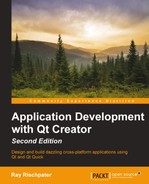Traditional GUI programming often involves easy-to-write but boilerplate state machines for controls to track control and application states. For example, a button might have several states: when the mouse hovers over it, when it's pressed, and then once pressed, a separate state for on or off in the case of a checkbox or a push button. While this code isn't hard to write, it does involve some writing, and more sophisticated interfaces require more of it.
Qt Quick provides an abstraction for this through its State construct, which groups a state's name as well as the condition under which it occurs, and which properties of an object should take on new values. We first saw this in Chapter 3, Designing Your Application with Qt Designer, when we wrote our own button component, reprinted here:
import QtQuick 2.3
Rectangle {
id: button
width: 64
height: 64
property alias operation: buttonText.text
signal clicked
color: "green"
Rectangle {
id: shade
anchors.fill: button;
color: "black"; opacity: 0
}
Text {
id: buttonText
anchors.centerIn: parent;
color: "white"
font.pointSize: 16
}
MouseArea {
id: mouseArea
anchors.fill: parent
onClicked: {
button.clicked();
}
}
states: State {
name: "pressed"; when: mouseArea.pressed == true
PropertyChanges { target: shade; opacity: .4 }
}
}Here, the button has two states: the default state in which the shade is fully transparent, and when the user is pressing the button—represented by the pressed state—setting the shade's opacity property to 0.4. The states field of an item can actually be an array; another way to write these states is to declare both explicitly, shown as follows:
states: [
State {
name: "pressed"; when: mouseArea.pressed == true
PropertyChanges { target: shade; opacity: .4 }
},
State {
name: "released"; when: mouseArea.pressed != true
PropertyChanges { target: shade; opacity: 0.0 }
}
]Each State construct can have more than one PropertyChanges element, each with its own target and property, so you can create sophisticated state transitions using simple declarations.
Qt Quick uses transitions to control the animation of a property when a state change occurs. To create a transition, define an animation; you can apply an animation on any property that can be changed, specifying the start and end values of the animation. Consider a simple animation on a mouse press such as the following:
import QtQuick 2.3
import QtQuick.Window 2.2
Window
{
visible: true
height: 360
width: 360
Rectangle {
id: rect1
width: 100; height: 100
color: "red"
MouseArea {
id: mouseArea
anchors.fill: parent
}
states: State {
name: "moved"; when: mouseArea.pressed
PropertyChanges { target: rect1; x: 100; y: 100 }
}
transitions: Transition {
NumberAnimation {
properties: "x,y"
easing.type: Easing.InOutQuad
}
}
}
}Here, the rectangle starts at the origin of the parent coordinate system, with MouseArea in the rectangle. When you press the mouse in the rectangle, the state of the rectangle changes to moved, and the rectangle's top-left corner moves to (100,100) on the parent's canvas. However, we also specify an animation, NumberAnimation, on the x and y properties, so the property change is animated to this value, with the easing curve we specify (a quadratic curve at both the start and finish of the animation).
- There are different animations for different kinds of properties. You can use
NumberAnimationto animate numeric properties, as you see here - There's also
ColorAnimation, which animates colors, andRotationAnimation, which animates rotations
Here's the QML to rotate a red rectangle in a half-circle when it's clicked on:
import QtQuick 2.3
import QtQuick.Window 2.2
Window
{
visible: true
height: 360
width: 360
Item {
width: 300; height: 300
Rectangle {
id: rect
width: 150; height: 100;
anchors.centerIn: parent
color: "red"
antialiasing: true
states: State {
name: "rotated"
PropertyChanges { target: rect; rotation: 180 }
}
transitions: Transition {
RotationAnimation {
duration: 1000
direction: RotationAnimation.Counterclockwise
}
}
}
MouseArea {
anchors.fill: parent;
onClicked: rect.state = "rotated"
}
}
}Again, the pattern is the same: we define a state with PropertyChanges, indicating the new property value, and then specify a transition over this property using an animation (in this case, RotationAnimation). Here, the transition has a duration specified in milliseconds. Note that the rotation only occurs once, and the rotation angles are bound by the values -360 and 360 degrees.
Note
For more information on the animation and transition framework in Qt Quick, see the Qt Quick documentation at http://qt-project.org/doc/qt-5/qtquick-statesanimations-animations.html and the Qt Quick Animation samples at http://qt-project.org/doc/qt-5/qtquick-animation-example.html.
